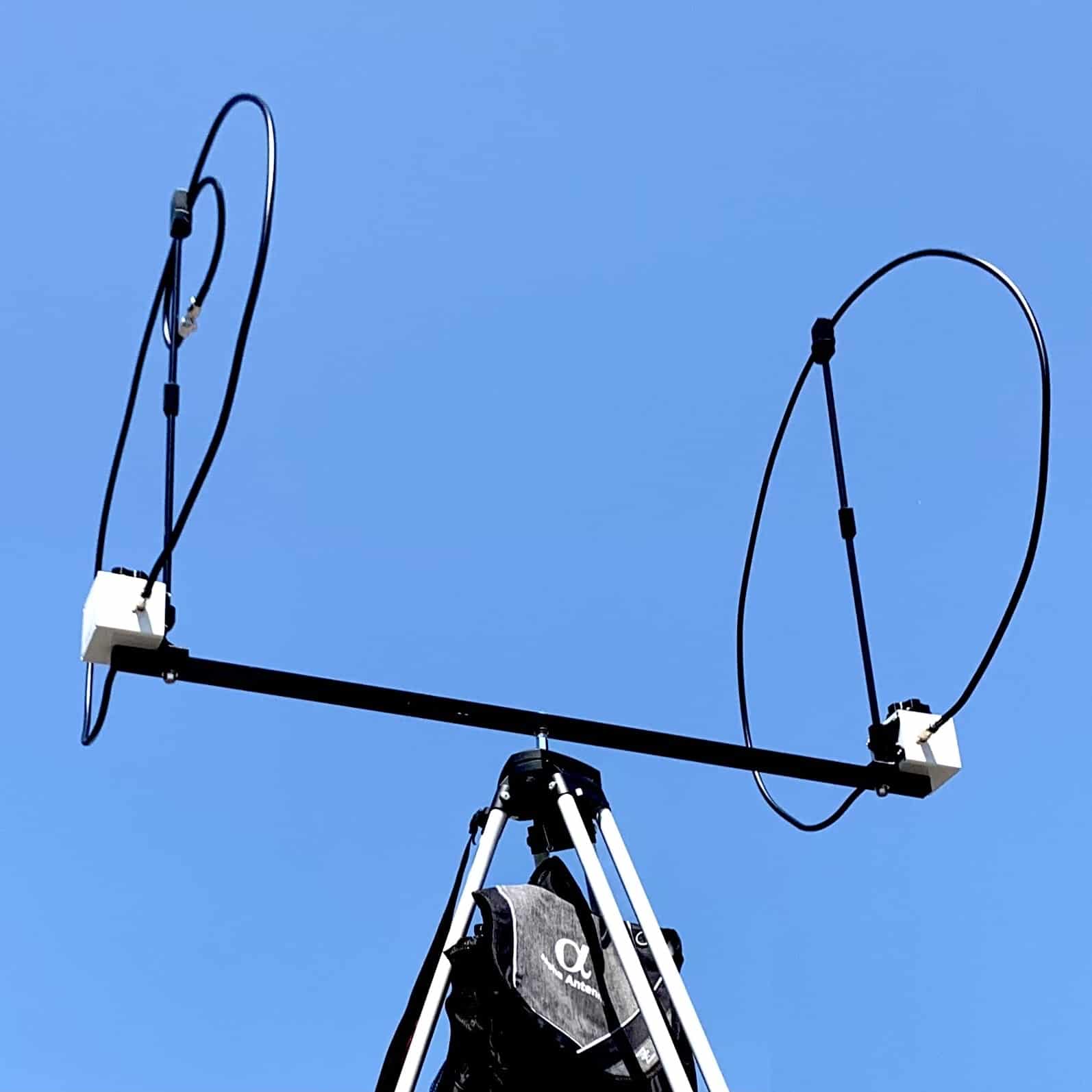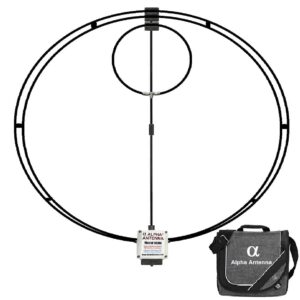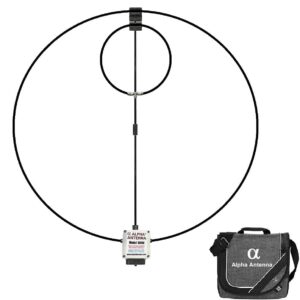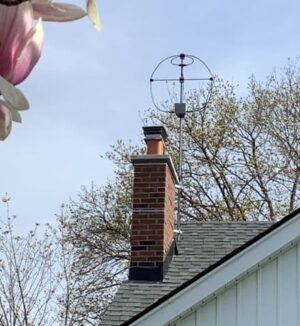Unleash the Power of Magnetic Loop MagLoop Antennas

A Compact Solution for Efficient HF Communications
Comparing the Alpha MagLoop and the Chameleon magnetic loop antennas
Introduction
In the world of radio communication, antennas play a vital role in transmitting and receiving signals. From towering arrays to small portable devices, antennas come in various shapes and sizes, each designed to optimize performance for specific applications. Among the diverse range of antennas, magnetic loop antennas have gained significant attention for their compact design, efficient performance, and versatility. In this article, we will delve into the fascinating world of magnetic loop antennas, exploring their working principles, advantages, applications, and potential limitations.
Understanding Magnetic Loop Antennas
Magnetic loop antennas are compact and often circular or rectangular-shaped devices that operate based on the principles of magnetic fields. Unlike traditional wire antennas that rely on their electrical length, magnetic loop antennas primarily utilize the magnetic field surrounding the loop to transmit and receive radio signals. The loop is usually made of a conductive material, such as copper or aluminum, which forms a closed loop or a coil.
Working Principles
When current passes through the loop, it generates a magnetic field that extends outward. This magnetic field interacts with the electromagnetic waves in the surrounding space, allowing the antenna’s inner loop to efficiently couple with the desired frequency formed by the outer loop. Magnetic loop antennas are known for their exceptional selectivity, enabling them to effectively tune into specific frequencies while minimizing interference from other frequencies.
Alpha MagLoop vs Chameleon CHA F-LOOP Antenna
| Alpha vs Chameleon MagLoop (Magnetic Loop) Antennas | |||
| MAGLOOP COMPARISON CHART | |||
| Specification | Alpha MagLoop | Chameleon CHA F-LOOP | Advantage |
| Power (PEP SSB) | 100W | 25W | Alpha handles 400% more power = Increases signal strength by 2 S-Units. |
| SWR published by each manufacturer | Operator tunable, typically not greater than 1.9:1 nor less than 1.12:1 at resonance. | Operator tunable, typically not greater than 3.0:1 at resonance. | Alpha has better SWRs = More efficient due to more power being radiated, but not reflected. |
| Circumference of the 10-40M element | 9-foot 4 inches | 7-feet 7 inches | Alpha element is 19% longer = More efficient on 10-40M due to more wire in the air. |
| Circumference of the 15-40M ‘booster’ cable | 11-foot 10 inches | 9-feet | Alpha's Booster cable is 24% longer = More efficient on 15-40M due to more wire in the air. |
| Circumference of the 40-80M elements | 21’ 2” (254 inches), consisting of (9’4” + 11’10” elements) | 17’ 9” (213 inches), consisting of (7’ 7” + 12’ 2” elements) | Alpha's element is 16% longer = More efficient on 40-80M due to more wire in the air. |
| Inner Loop design | Shielded faraday loop | Non-shielded inner loop | Alpha’s pick-up loop has RFI rejection |
| IP Rating | IP53 – Protected against dust limited ingress, no harmful deposits. Protected against direct sprays of water up to 60 degrees from the vertical. | IP30 – Protected from tools and wires greater than 2.5 millimeters. Not protected from liquids. | Alpha’s MagLoop offers superior protection from the environment. |
| Mechanical switches | No | Yes | Alpha increases efficiency by not using lossy mechanical switches. |
| Inductive tuning | Yes. Distance between the inner & outer loops is adjustable. | No | Alpha’s inner loop can be moved up or down the center mast, providing a greater level of control over efficiency. |
| OPTIONS | |||
| Optional 6M/VHF/UHF | Yes (add $44.95) | No | Alpha optionally supports 6M/VHF/UHF |
| Optional Remote | Yes, $250 (Runs off any DC power source.) | Yes, $350 (Runs off a 9V battery.) | Alpha’s optional remote costs $100 less |
| Optional Tripod available? | Yes | No | Alpha has several optional tripods |
| Optional SWR Indicator? | Yes | No | Alpha has an optional SWR Indicator |
| Optional Base Loop? | Yes | No | Alpha has a 10-40M base MagLoop |
Advantages of Magnetic Loop Antennas
- Compact Size: One of the significant advantages of magnetic loop antennas is their small physical footprint. Their compact size makes them ideal for various applications where space is limited, such as apartments, small houses, or portable setups.
- Efficiency: Magnetic loop antennas exhibit high efficiency in transmitting and receiving signals. The concentration of the magnetic field within the loop enables them to efficiently couple with the desired frequency, resulting in improved signal strength and reception.
- Directional Performance: Magnetic loop antennas often possess a directional radiation pattern. When this pattern is not impeded upon by other objects, turning the loop can enable the operator to transmit and receive stronger signals patterns, enhancing signal reception from a specific direction while minimizing interference from others.
- Reduced Noise: Due to their inherent design and smaller size, magnetic loop antennas can help reduce noise and interference from unwanted signals, resulting in cleaner reception and improved signal-to-noise ratio.
Applications of Magnetic Loop Antennas
- Amateur Radio: Magnetic loop antennas are highly popular among amateur radio operators (hams) for their compactness, portability, and excellent performance. They can be easily deployed in restricted spaces, such as balconies or attics, enabling hams to enjoy efficient communication even in challenging environments.
- Portable Communication: Magnetic loop antennas are widely used in portable communication setups, such as field operations, expeditions, or emergency communication systems. Their small size and efficiency make them a go-to choice for radio operators who require reliable communication on the move.
- Military Radio: Magnetic loop antennas are used where there is a need for clandestine communications, providing a safe and hidden solution to HF communications for military deployments. Their compact design and directional capabilities allow for focused coverage to meet mission directives.
Limitations and Considerations
While magnetic loop antennas offer numerous advantages, they also have some limitations and considerations to keep in mind:
- Bandwidth: Magnetic loop antennas typically have a narrow bandwidth, limiting their ability to cover a wide range of frequencies. Tuning the loop for different frequencies may require adjustments to the tuning be made.
- Power Handling: Magnetic loop antennas are best suited for low-power applications of 100W PEP SSB or less. High-power transmissions can lead to increased voltage across the loop and potential issues with arcing.
- Size and Efficiency Trade-Off: As the size of the magnetic loop decreases, efficiency may be compromised. Designing an optimal magnetic loop antenna involves finding a balance between size constraints and desired performance. So, selecting a loop with the largest circumference is important.
Conclusion
Magnetic loop antennas provide a compact and efficient solution for various communication needs. Their ability to maximize signal reception, reduce noise, and offer directional capabilities makes them an attractive choice for amateur radio enthusiasts, portable communication setups, and military radio operators. While they have certain limitations in terms of bandwidth and power handling, magnetic loop antennas continue to prove their worth in scenarios where space constraints or portability are paramount. As technology advances, we can expect further improvements and refinements in magnetic loop antenna designs provided by Alpha Antenna, unlocking even more possibilities for efficient and reliable communication.
-
Sale Product on sale10-80M 100W* MagLoop (**6M/VHF/UHF)
$600.00Original price was: $600.00.$550.00Current price is: $550.00.Rated 5.00 out of 5 based on 85 customer ratings -
Sale Product on sale10-40M 100W MagLoop (*6M/VHF/UHF)
$550.00Original price was: $550.00.$500.00Current price is: $500.00.Rated 5.00 out of 5 based on 79 customer ratings -
10-40M 100 Watt MagLoop + Remote$999.00Rated 5.00 out of 5 based on 5 customer ratings



